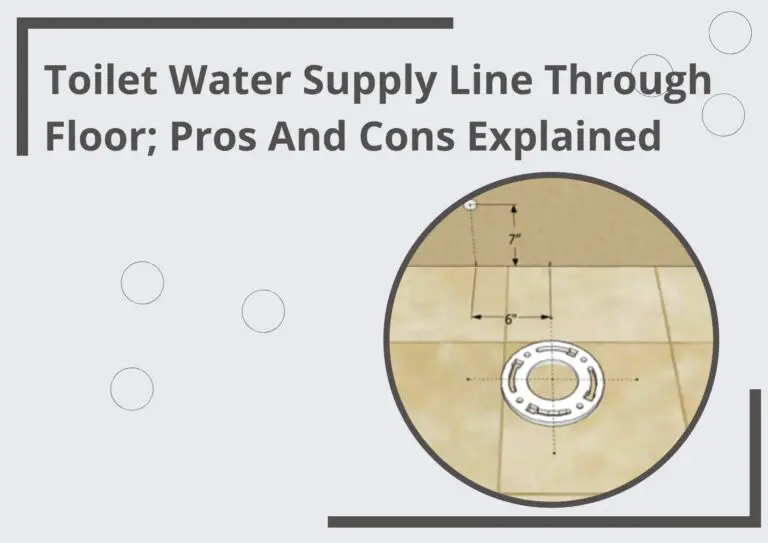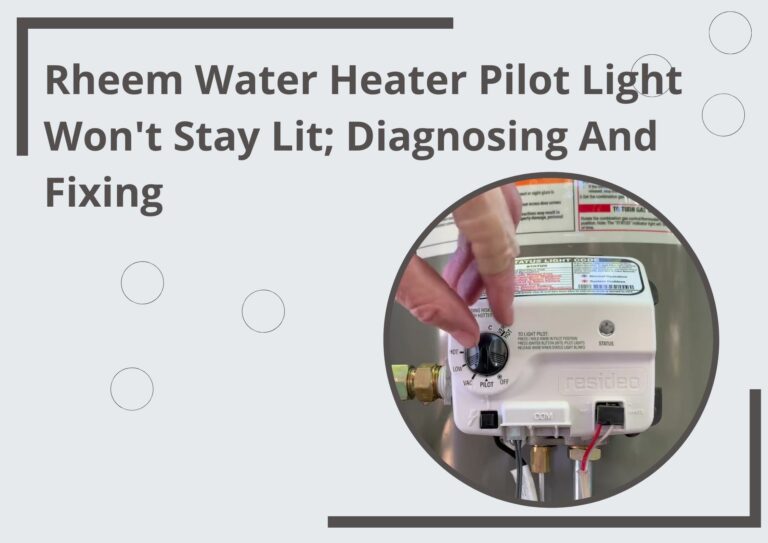Rheem Chamber Sensor Failure: A Comprehensive Guide
“Rheem Chamber Sensor Failure: A Comprehensive Guide” explores the common issue of chamber sensor failure in Rheem water heaters. These sensors play a vital role in ensuring the safety and efficiency of your water heater by monitoring combustion chamber temperatures.
This article provides valuable insights into identifying symptoms, troubleshooting, and preventive measures to keep your water heater running smoothly while safeguarding your home against potential hazards.
Table of Contents
What causes Rheem Chamber Sensor Failure?

Various factors can cause chamber sensor failure in Rheem water heaters. Here are some common causes explained:
01. High Temperatures
The primary purpose of the chamber sensor is to monitor the temperature inside the combustion chamber. If the temperature becomes excessively high, it can trigger a shutdown to prevent potential fire or explosion hazards. Several factors can lead to high temperatures:
- Incomplete Combustion
Incomplete combustion of natural gas or propane can cause a buildup of heat in the chamber, leading to high temperatures. This might be due to issues with the burner, such as clogs or malfunctions.
- Blocked Venting
If the venting system is blocked or obstructed, it can disrupt the proper flow of combustion gases, causing heat to accumulate in the chamber.
- Gas Pressure Problems
Irregular gas pressure can affect combustion, resulting in high temperatures. Gas pressure should be within the manufacturer’s recommended range.
02. Sensor Damage or Corrosion
The chamber sensor itself can become damaged or corroded over time due to exposure to high temperatures, moisture, or contaminants. Common causes of sensor damage include:
- Age and Wear
Like all components, sensors have a limited lifespan and may deteriorate over time.
- Moisture
Exposure to moisture, either from leaks or condensation within the combustion chamber, can lead to sensor corrosion.
- Contaminants
Dust, dirt, or debris in the combustion chamber can accumulate on the sensor, affecting its accuracy and reliability.
03. Electrical Issues
The chamber sensor relies on electrical connections to communicate with the water heater’s control system. Electrical problems can disrupt the sensor’s function:
- Faulty Wiring
Loose or damaged electrical connections between the sensor and the control board can lead to communication errors or sensor failure.
- Control Board Malfunction
A malfunctioning control board may not properly interpret the signals from the chamber sensor, potentially causing it to shut off the gas valve unnecessarily.
It’s important to note that diagnosing the exact cause of chamber sensor failure may require professional expertise. If you encounter this issue with your Rheem water heater, it’s recommended to contact a qualified technician who can thoroughly inspect the system and address the problem accordingly. Regular maintenance and inspections can also help prevent some of these causes of chamber sensor failure.
What are the Symptoms of Chamber Sensor Failure?
Chamber sensor failure in a Rheem water heater can manifest through various symptoms. These symptoms are important indicators that there may be an issue with the chamber sensor or related components. Here are the common symptoms of chamber sensor failure:
No Hot Water
When the chamber sensor detects a problem, it may shut off the gas valve as a safety measure. This action prevents the water heater from heating the water, resulting in a lack of hot water throughout your plumbing fixtures.
Blinking Error Code
Many Rheem water heaters come equipped with a diagnostic system that can display error codes when a problem occurs. If the chamber sensor fails or detects an issue, the water heater’s control panel may show an error code. These codes often appear as numbers or alphanumeric combinations (e.g., “9” or “A102”).
Toilet Water Supply Line Through Floor; Pros And Cons Explained
plumbinsight.com
Pilot Light Won’t Stay Lit
In some cases, chamber sensor failure can affect the stability of the pilot light. If the sensor is malfunctioning, it may incorrectly interpret the chamber’s temperature and cause the pilot light to go out repeatedly. This is another safety feature designed to prevent further operation in potentially unsafe conditions.
Intermittent or Inconsistent Heating
Chamber sensor problems can lead to erratic heating performance. You may notice that the water heater heats inconsistently or that it shuts off unexpectedly during operation.
Visible Damage or Corrosion
Sometimes, chamber sensor failure is visually apparent. You may notice damage or corrosion on the sensor itself or in the surrounding area. Physical damage or corrosion can affect the sensor’s ability to accurately detect temperature.
It’s essential to address these symptoms promptly, as chamber sensor failure can compromise the safety and efficiency of your water heater. Keep in mind that while these symptoms are indicative of a chamber sensor issue, they may also be caused by other problems with the water heater. Therefore, a professional diagnosis and repair are recommended to ensure the accurate identification and resolution of the issue.
How to troubleshoot Chamber Sensor Failure?

Troubleshooting chamber sensor failure in a Rheem water heater involves a systematic approach to identify and address the issue. Here’s a step-by-step guide to help you troubleshoot chamber sensor failure:
Check the Error Code
If your Rheem water heater has a diagnostic system with an error code display, start by checking the error code. Error codes like “9” or “A102” may indicate a chamber sensor problem. Refer to your water heater’s manual or Rheem’s documentation for specific error code meanings.
Inspect the Chamber Sensor
Locate the chamber sensor, which is typically positioned near the bottom of the combustion chamber. Look for any visible signs of damage, corrosion, or loose connections. If you notice physical damage or corrosion, the sensor likely needs replacement.
Clean the Combustion Chamber
A dirty combustion chamber can affect the chamber sensor’s performance. Use a vacuum cleaner or a brush to remove dust, debris, or soot buildup from the combustion chamber. Ensure that the chamber is clean and free of obstructions.
Check the Gas Valve
If the chamber sensor appears to be in good condition and the combustion chamber is clean, the problem may be related to the gas valve. Check the gas valve for proper operation:
- Ensure that the gas supply to the water heater is turned on.
- Observe the gas valve’s operation during a heating cycle. It should open when the water heater calls for heat and close when the set temperature is reached.
- If the gas valve does not open or close properly, it may need replacement or adjustment. Consult your water heater’s manual for specific guidance on gas valve troubleshooting.
Verify Gas Pressure
Irregular gas pressure can impact combustion and lead to chamber sensor issues. Consult a professional technician to measure and adjust the gas pressure if needed. Gas pressure should be within the manufacturer’s recommended range.
Replace the Chamber Sensor (if necessary)
If you’ve confirmed that the chamber sensor is the problem and it’s damaged or not functioning correctly, you’ll need to replace it. Follow the manufacturer’s instructions for replacing the sensor. This typically involves disconnecting electrical connectors and unscrewing the sensor from the combustion chamber.
Perform a Test Run
After addressing the issue (whether by cleaning, replacing, or adjusting components), turn on the water heater and monitor its operation. Check if the symptoms of chamber sensor failure persist.
Be sure to follow safety precautions while conducting this test run, and keep an eye out for any error codes or abnormal behavior.
Annual Servicing
To prevent future chamber sensor failures and ensure the overall health of your water heater, consider scheduling annual maintenance with a qualified technician. They can inspect the chamber sensor and other components, clean the unit, and make any necessary adjustments.
If you’re uncomfortable with any of these troubleshooting steps or if the issue persists after your attempts, it’s highly advisable to contact a professional technician or Rheem customer support for further assistance. Safety should always be a priority when working with gas water heaters.
Honeywell (Rheems) water heater control valve, chamber sensor failure
What can you can do to prevent chamber sensor failure?
To prevent chamber sensor failure in your Rheem water heater and ensure its continued safe and efficient operation, follow these proactive measures.
- Firstly, schedule annual maintenance checks by a qualified technician who can inspect and service your water heater, paying close attention to the chamber sensor’s condition and cleanliness.
- Secondly, keep the combustion chamber clean by periodically removing any dust, debris, or soot buildup, which can interfere with sensor performance.
- Thirdly, regularly check for gas leaks in the supply lines and connections, and ensure proper ventilation to maintain a safe combustion environment.
If you encounter any signs of damage or corrosion on the sensor during inspections, promptly replace it. Lastly, follow Rheem’s recommended maintenance guidelines provided in the user manual to extend the lifespan of your water heater and prevent sensor failure.
Rheem Water Heater Pilot Light Won’t Stay Lit; Diagnosing And Fixing
plumbinsight.com




